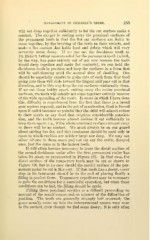Page 403 - My FlipBook
P. 403
MANAGEMENT OF CHILDREN'S TEETH. 255
will not drop together sufficiently to let the cut surface make a
contact. The danger in cutting away the proximal surfaces of
the permanent teeth is that the flat cut surfaces are liable to
come together, by the twisting of the teeth in their sockets, and
make a flat contact that holds food and debris which will very
certainly cause decay. If we can cut the deciduous teeth as
Dr. Robert Arthur recommended for the permanent teeth (which,
by the way, has gone entirely out of use now because the teeth
would drop together and make flat contacts), we can hold the
deciduous teeth in position and keep the surfaces in a form that
will be self-cleaning until the normal time of shedding. One
should be especially careful to make cuts of such form that food
going into them will slide toward the lingual and pass out in that
direction, and in this way keep the cut surfaces continually clean.
If we cut these boldly apart, cutting away the entire proximal
surfaces, the teeth will usually not come together entirely because
of the wide spreading of the roots. In cases in which I have done
this, difficulty is experienced from the fact that there is a broad
gum septum exposed, and in the act of mastication, food is forced
upon it and it becomes so painful that the child will almost refuse
to chew meats or any food that requires considerable mastica-
tion, and the teeth become almost useless if cut sufficiently to
keep them apart, i. e., if the whole proximal surfaces are cut away
so there will be no contact. We must always be on our guard
about cutting too far, and this treatment should be used only in
cases in which cavities are neither large nor deep. "We may use
silver nitrate in these cases and not cut out the entire decayed
area, just the same as in the incisor teeth.
It will often become necessary to treat the distal surface of
the second deciduous molar after the first permanent molar has
taken its place, as represented in Figure 185. In that case, the
distal surface of the temporary tooth may be cut as shown in
Figure 186, but in no case should the mesial surface of the per-
manent molar be cut in this way. If that tooth has a decay, every
step in its treatment should be to the end of placing finally a
filling in perfect form. Temporary expedients may be necessary
to gain the conditions for a successful operation, but when these
conditions can be had, the filling should be made.
Filling these proximal cavities is a difficult proceeding on
account of the sensitiveness and on account of the difficulties of
position. The teeth are generally strongly bell crowned; the
gums usually come up into the interproximal spaces very near
to the contact, even though we find some decay ; it is only after


